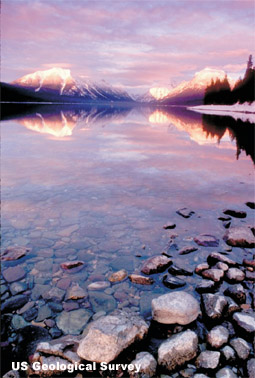Glacier National Park in peril – Human disruption of the climate is the greatest threat ever to United States national parks. Glacier National Park was identified in an October 2009 report, National Parks in Peril: The Threats of Climate Disruption, also by the Rocky Mountain Climate Organization (RMCO) and the Natural Resources Defense Council, as one of the 25 national parks most vulnerable to the effects of an altered climate.

Snowcapped mountains – a thing of the past.
According to the new RMCO/NRDC report:
• A new analysis done by RMCO for the report shows that at the one weather station in the park with relatively long-term records, a West Glacier station at park headquarters, the average temperature for the decade just completed (2000-2009) was 2.0°F hotter than the station’s 1950-1979 average. That is exactly double the average global temperature increase of 1.0°F in the past decade, again compared to a 1950-1979 baseline. For both West Glacier and the planet as a whole, the last decade was the hottest in the history of instrumental measurements.
• A loss of wildlife in Glacier could result from human-caused climate change. This could disrupt the unique mix of natural wildlife the park now supports, which offers Americans the best chance they have in the lower 48 states to see the full range of mammal predators present at the time of European settlement of the continent, including grizzly and black bears, wolves, lynx, wolverines, mountain lions, and more, as well as other large mammals including mountain goats, bighorn sheep, and elk. The park’s staff is concerned that climate change could lead to “wholesale changes in species composition.”
• According to a recent study updated by RMCO for the report, western Montana in 2000- 2008 experienced eight more days a year of 90°F or higher temperatures, and eight days a year of 0°F or lower temperatures, than in 1900 through 1979.
• A just-completed update by the U.S. Geological Survey, not previously reported publicly, finds that of the 37 named glaciers in the park, only 25 remain large enough to still be considered glaciers. Of the 12 that have melted away, 11 have done so since 1966. Overall glacier acreage in the park in 2005 was 18 percent smaller than in 2005.
• Glacier is on track to lose all or nearly all of its glaciers, perhaps in the relatively near future. Seven years ago, scientists projected that even modestly hotter summers could eliminate by 2030 all glaciers in one basin in the park. Since that study was published, the glaciers in the basin have melted faster than projected. One author of that study, Daniel B. Fagre of the U.S. Geological Survey’s Northern Mountain Science Center, says the basin’s glaciers now could be gone in just 10 years.
• A hotter climate is also expected to reduce snowfall and snowpack accumulation in the park. One recent study projects that near the end of this century, peak snowpack levels in the park may be reached 41 days earlier than in mid-20th century, and that snow could cover the ground for about 70 fewer days a winter. With mountains not snow-capped as much or as long into the summer, the scenery that draws most visitors to Glacier — including stunning waterfalls and lakes — would be affected.
Source: Glacier National Park in Peril:The Threats of Climate Disruption. Full report here.
